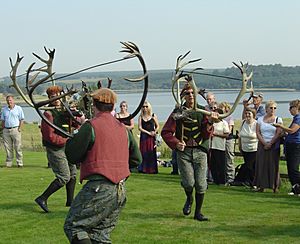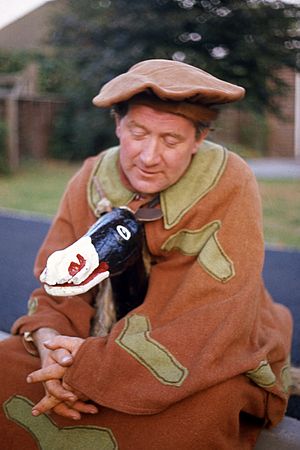Abbots Bromley Horn Dance facts for kids
The Abbots Bromley Horn Dance is an English folk dance that probably dates back to the Middle Ages. The dance takes place each September in Abbots Bromley, a village in Staffordshire, England. The modern version of the dance involves reindeer antlers, a hobby horse, Maid Marian and a Fool.
Contents
Origins
There are no recorded references to the horn dance before Robert Plot's Natural History of Staffordshire, written in 1686. However, there is a record of the hobby horse being used in Abbots Bromley as early as 1532, and it is possible that the horn dance component of the custom was also present at that time but was not commented upon by the writer. A radiocarbon analysis discovered that the antlers used in the dance date to the 11th century.
According to some, the use of antlers suggests an Anglo-Saxon origin. It has been speculated, for example, that the dance originated in the pagan period and was connected with the ruling dynasty of Mercia, based some 15 miles away at Tamworth, who owned extensive hunting lands in Needwood Forest and Cannock Chase surrounding Abbots Bromley. On this theory, the royal forester organised sympathetic magic rituals to ensure a plentiful catch each year, a tradition that survived into Christian times and gradually came to be seen as affirming the villagers' hunting rights. Even after the lands were granted to Burton Abbey in 1004 a forester was still employed. By the 16th century, when the abbey was dissolved, this was a hereditary position with the title "Forester of Bentylee", Bentylee being the wooded area of the parish. From then onwards the dance remained the prerogative of the Bentley family, but it was passed on to the Fowell family in 1914. The Fowells continue to run it to this day.
Some folklorists point out that, while the reindeer antlers date to the 11th century, reindeer were long since extinct in England and Wales (and probably Scotland), and there is no evidence that any domestic reindeer herds remained at that time. It follows that the antlers must have been imported from Scandinavia at some point between the 11th and 17th centuries. This lends weight to the theory that the custom began with only a hobby horse and that the horn dance component was added later.
Event
The Horn Dance attracts a large number of visitors to the village. As well as the dance itself, Wakes Monday sees a fair on the village green, Morris dancing and numerous other attractions. The right to hold this fair was granted to the village in 1221.
Date and schedule of performance
The Horn Dance takes place on Wakes Monday, the day following Wakes Sunday, which is the first Sunday after 4 September. Violet Alford, a prominent student of folklore and folk dance, wrote in 1940 that the dance had previously taken place on the Twelfth Day, during the first week of January. According to Robert Plot, it has also been performed on Christmas Day and New Year's Day, in addition to the local Wakes Monday, though upon its revival in 1660 it was confined to the last named alone.
The dance starts at 8 a.m. with a service of blessing in St Nicholas's Church, where the horns are housed between dances. The dance begins on the village green, then passes out of the village, but not out of the parish, to Blithfield Hall, which is owned by the Bagot family. The dancers return to the village in the early afternoon, and make their way around the pubs and houses. Finally, at about 8 p.m., the horns are returned to the church, where a service of Compline is held.
Dancers
There are 12 dancers. Six carry the horns and they are accompanied by a musician playing an accordion (a violin in former times), Maid Marian (a man in a dress), the Hobby-horse, the Fool (or Jester), a youngster with a bow and arrow, and another youngster with a triangle. Traditionally the dancers were all male, but in recent years girls have carried the triangle and the bow and arrow.
Until 1914 the dancers were all members of the Bentley family. The dance was passed on to the related Fowell family in 1914, and they maintaion their connection with it to this day, though none of them lives in the village any longer. They have allowed visitors to "dance in" if asked politely, and often invite musicians and others to take part.
Antlers
The horns are six sets of reindeer antlers, three white and three black. In 1976 a small splinter was radiocarbon-dated to around 1065. Since there were no reindeer in England at that date the horns must have been imported from Scandinavia.
The six sets of horns were formerly kept in the Village Hall, which is now the Goat's Head Inn, beside the Butter Cross. Later they were kept in the tower of St Nicholas's Church, being hauled into position on the walls by ropes, but in the period between the world wars brackets were provided for them in the Hurst Chapel in the church, where they were mounted on wooden heads carved by village craftsmen. The horns currently in use were brought from Constantinople (Istanbul') by Lord Paget, who was British Ambassador to the Ottoman Empire, in the 18th century, but there may have been horns in use long before. The heaviest of the horns weighs 36 pounds (16 kg) and one of the horns has 36 points.
The antlers are mounted on small heads carved from wood. Since 1981 the horns have been the property of Abbots Bromley Parish Council. An alternative set of antlers (taken from red deer) are kept for use when the dancers are asked, as they frequently are, to perform outside the parish boundaries.
Dance

The dance itself is simple, since the antlers themselves have some weight to them and are large and bulky.
As described by Cecil Sharp in 1911, there are ten people in the dance: six dancers bearing the horns, Maid Marian, the Hobby-horse, the boy with a bow and arrow, and the Fool. He describes the circular dance as being done with the participants in a single line, but it is currently performed with the dancers in a double column.
This compares with the twelve dancers listed above.
Music
Cecil Sharp gives two versions of the music. In his 1911 written description of the dance Sharp says he saw it being performed to "Yankee Doodle" and another simple melody in G major in 4/4 time. However, in his preface to the sheet music (dated 1912) Sharp says that he had received a version from a Mr. J. Buckley, who had noted down the music in 1857 or 1858 from "the fiddling of William (or Henry) Robinson, a wheelwright of Abbots Bromley, who was famous at the time as the only man who could play the Horn Dance air." This version has three sections in G and C minor, in 6/8 time.
Abbots Bromley Horn Dance Stamps issue
- 2019 - Royal Mail issue a collectable stamps edition of UK Weird and Wonderful Customs which includes Bog snorkelling at Llanwrtyd Wells, World Gurning Championship at Egremont, Up Helly Aa in Lerwick, Burning the Clocks in Brighton, 'Obby 'Oss festival in Padstow, Samhain Celtic festival (Halloween) at Derry, Cheese-Rolling at Cooper's Hill and Horn Dance at Abbots Bromley




